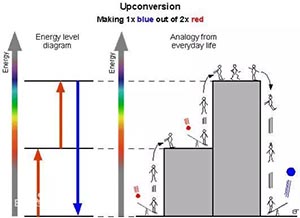Up-conversion luminescent materials under the excitation of the pump light source will absorb the energy of the pump light source and convert the energy into light energy, and its conversion capacity is called luminous efficiency S.25]. Luminous efficiency is one of the reference bases to distinguish the quality of luminous materials, and the luminous efficiency of luminous materials is affected by many factors. A large number of experimental results show that the main factors affecting the upconversion luminescence efficiency are substrate material, rare earth ion doping concentration and material preparation technology.
- Substrate material
Upconversion luminescence requires the phonon energy of the substrate to be low, which is conducive to the realization of upconversion luminescence. Different substrates lead to different crystal fields of rare earth ions, which affects the upconversion luminescence efficiency of rare earth ion doped materials. In other words, when the phonon energy of the matrix is not much different from the frequency of the excitation light source, the matrix will absorb part of the excitation energy of the pumped light source, resulting in the upconversion luminescence efficiency of the doped rare earth ions is reduced. - Doping concentration of rare earth ions
When the doping concentration of rare earth ions is too high, the concentration of rare earth ions will be quench, resulting in the reduction or even disappearance of the luminous intensity, thus reducing the luminous efficiency. - Material preparation process
Different preparation processes lead to different phase structure, crystal size, crystallinity and crystal defects of the prepared materials, which will affect the luminous efficiency of rare earth ions. Because it is related to crystals, this factor can also be attributed to the difference in the crystal field environment in which the rare earth ions are located, that is, different kinds of substrates.
